A “Slow” Recipe For Polenta
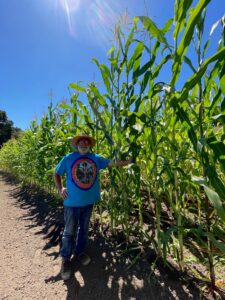
These corn plants have to be 10 feet tall- or more! I’m 6’1″
Here’s a “Slow Food” recipe for Polenta: I start by planting the corn.
Actually, it was my friend, Annabelle, who started the recipe for me by giving me some heirloom “Otto File” corn seed that she collected when traveling through Italy a number of years ago. “Otto File” means “eight rows” in Italian, and each ear of Otto File corn does display only eight rows of golden kernels. While other varieties of corn might be be more productive, Otto File is the “go to” corn for real, old-school polenta. Since I had Italian restaurants eager to make their own polenta “from scratch,” Annabelle’s gift of the correct seed was well timed and much appreciated. We planted the seed and grew it out for 3 years, saving only the best, longest ears of each year’s harvest until we had enough quality seed for a commercial scale planting. If you want to plant your own patch of Otto File corn all you need to do is buy a pound of seed from us at our next pop-up and save it to plant in the spring instead of milling it up to cook.
If you are going to make polenta, know this: “Store bought” polenta is “shelf-stable.” That is to say, each kernel of corn in store-bought polenta has been cracked and “de-germed.” The “germ,” or that embryonic part of the seed that germinates, has been mechanically removed and processed to make other, value-added products. When you make your own polenta from the corn meal you grind yourself you will probably not be able to (or want to ) de-germ the corn before grinding it up. The downside of grinding whole corn is that, once ground, the fresh ground meal will not hold up for as long as the industrial corn meal that has had the hearts removed. If you buy our corn to make meal from take care to grind what you intend to use promptly or the meal will eventually spoil. The upside of grinding your own “whole grain” corn is that it will be much richer and more flavorful that store bought polenta meal BECAUSE it is whole grain.
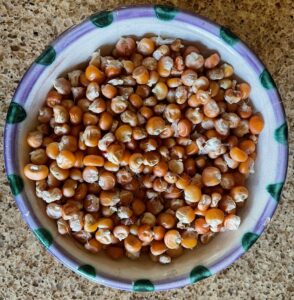
A bowl of shelled “Otto File” corn. I grind it “as is” and it seems to work out fine.
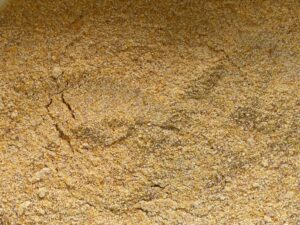
I like a mix of fine and coarse ground cornmeal for the most toothsome and interesting polenta.
To grind the corn into meal I use a Vitamix food processor. No, I am not an influencer who is going to profit from brand promotion. I find that three, separate 15 second pulses on the “smoothie” icon works out to make the best meal. To my taste, a blend of finely powdered meal with some larger chips or pieces of corn makes for a more interesting texture. I generally pass the meal through a sieve at least once to remove any really large pieces of corn that may not cook at the same rate as the rest of the meal. If necessary, I will re-grind the biggest pieces one pore time before preparing the polenta.
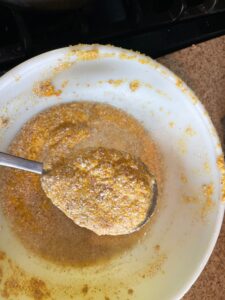
This is the polenta “mud” that I stir into the boiling water- SO much easier than letting a thread of dry grain trickle into the boiling water.
Marcella Hazan, the quintessential Italian Grandmother and the author of “Essentials of Classic Italian Cooking” recommends a ration of seven cups of water to one and 12/3rds cup of corn meal for perfect polenta. I’m not going to argue with her, but I always keep a tea kettle of hot water nearby when I’m cooking polenta so that I’m ready if I need to add more water. Think about it; polenta really only has four ingredients; corn meal, water, salt…….and time! If you want to cook a pot of polenta for a long time you will be rewarded with a richer flavor and a more velvety texture. Marcella cooks her polenta for 45 minutes but I like to cook mine for six hours.
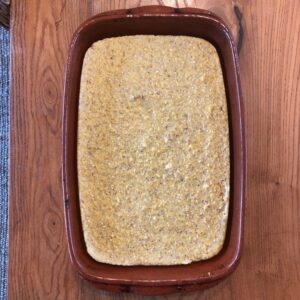
A tray of hot polenta cooling in a baking pan. Even relatively liquid polenta will “set” well iin an hour or so f it has been cooked for a long time.
Once I have my pot of water boiling I add a pinch of herbal salt to the water. Then I stir a big spoonful of “corn mud” into the roiling water. Once the water is at a boil again I add another big spoonful until I’ve put all the meal into the water and the water is boiling again. Then I turn the flame down so that that polenta is barely bubbling. I’ll come back and stir it every 15 minutes or so but, basically, the idea is to let the polenta cook and cook and cook and cook SLOWLY. You may notice that the level of cornmeal gradually drops in the pot over time. I will add a dash of hot water if I feel like things are getting too thick too quick, but I usually just leave the pot to slowly bubble away.
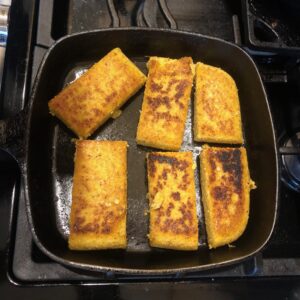
Slices of polenta are perfect fried or baked. I like to get the polenta squares crispy on each side while keeping them moist and tender inside.
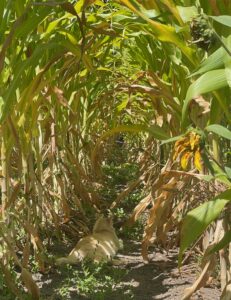
Our cat, Samson, enjoys the cool of the corn patch.
After five or six hours of slowly bubbling away I feel like the polenta is ready. I’ll pour the hot, soft polenta into wide ceramic casserole dishes and let it cool at room temperature. Once it is cool the polenta will congeal into a substance thicker than jello, which can be easily sliced and baked or fried. I like to fry the polenta in long, thick rectangles, taking time to turn each piece so that it is gilded and crispy on each side. If you wanted to you could fry up little tiny squares to use as croutons in a salad. I like my polenta served with a sauce as though it were a pasta. I always make a huge batch and freeze half of it so that I can whip up some polenta even when I don’t have time.
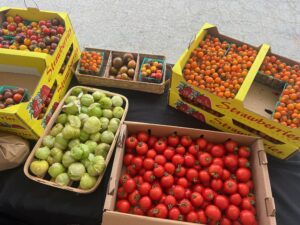
Setting up for the Corralitos Farm and Garden Market
We are in the middle of pop up season. This coming Saturday we will be in Los Gatos. In the weeks to follow we will return to Berkeley, San Francisco, and Palo Alto, as well as popping up here in Corralitos at the Sunday Farmers Market. We will be featuring lots of tomatoes, tomatillos, herbs and flowers, but we will also have Otto File corn for sale. Keep an eye on our newsletter for updates. You can pre-order for the our upcoming Los Gatos pop-up here https://www.mariquita.com/tomatopalooza-popup/
2 thoughts on “A “Slow” Recipe For Polenta”
Leave a Reply
You must be logged in to post a comment.



I love your descriptive essay on making polenta, you’ve inspired me to make some! Do you leave the polenta covered as it cooks?
No it is uncovered during the stirring process in order to let water evaporate off as it is cooking on the slow fire.